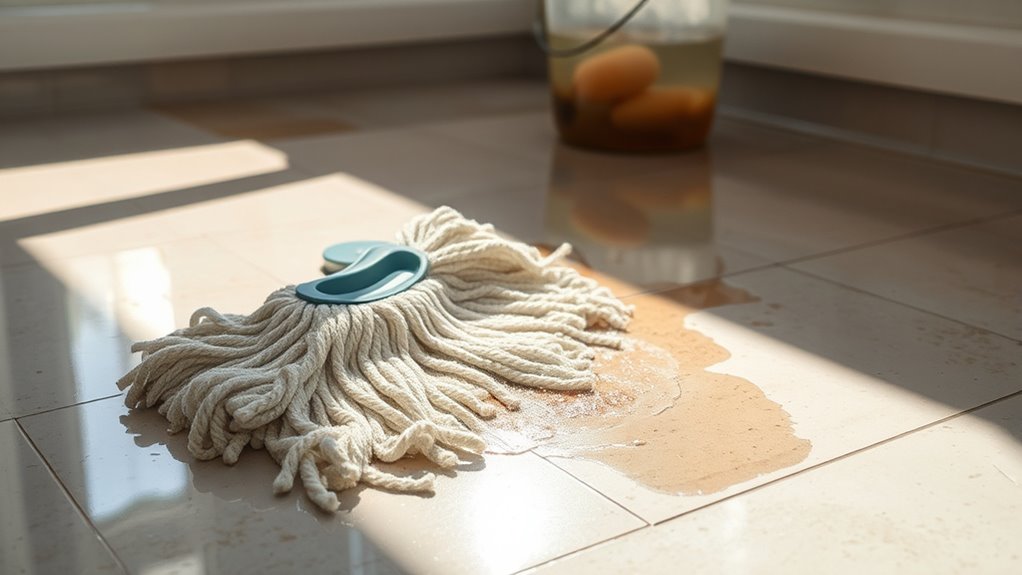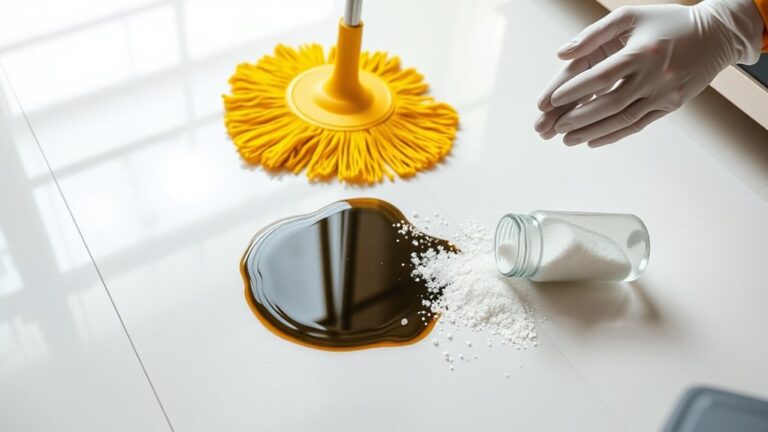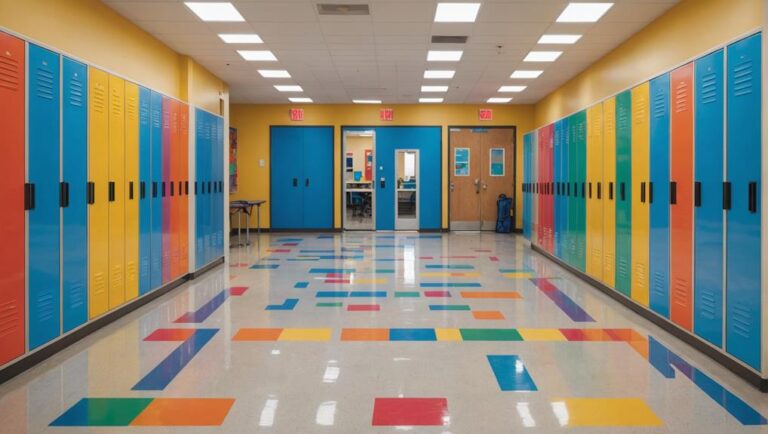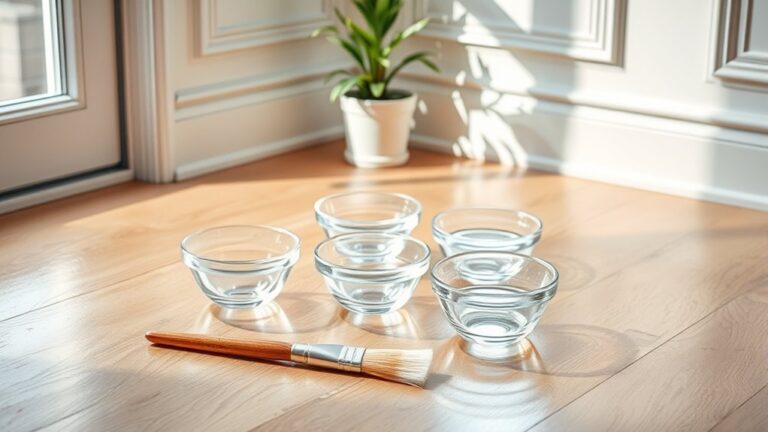If your floor feels sticky after mopping, it’s likely due to leftover detergent, using too much cleaner, improper rinsing, or dirt buildup. You can fix it by mopping again with clean water, using a diluted vinegar solution, or gentle dish soap to remove residue. Make sure to wring out the mop well and avoid overusing cleaning products. Using the right techniques and products will prevent stickiness and keep your floors fresh—there’s more to learn about effective cleaning and maintenance.
Common Causes of Sticky Floors After Mopping

Although you might expect your piso to be clean and smooth after mopping, sticky residue can sometimes remain, making the surface unpleasant to walk on. This often results from a few common causes related to your cleaning habits and the type of floor materials you have. For instance, using too much detergent or not rinsing properly can leave a film that feels tacky. Some floor materials, like vinyl or laminate, are more prone to retaining residue compared to tile or sealed hardwood. Additionally, mopping with dirty water or skipping a final dry can contribute to stickiness. By adjusting your cleaning habits—such as using the right amount of cleaner and ensuring thorough rinsing—you’ll maintain the freedom to enjoy a fresh, non-sticky floor without hassle.
How Cleaning Products Affect Floor Stickiness
The type of cleaning products you use plays a big role in whether your floor ends up sticky after mopping. Some cleaning product types, especially those with waxes, detergents, or heavy fragrances, can leave behind a residue buildup that feels tacky underfoot. If you’re using too much product or a formula not suited for your floor surface, sticky residue is almost inevitable. To avoid this, choose cleaning products specifically designed for your floor type—like pH-neutral cleaners for hardwood or tile. Also, make sure to dilute concentrated products properly, as undiluted cleaners increase residue buildup. Sticking with the right product reduces stickiness and keeps your floors feeling clean and free, letting you enjoy your space without that annoying sticky sensation.
The Role of Water Temperature and Mop Technique

You might not realize that the temperature of your water can impact how clean your floor feels after mopping. Using warm water helps dissolve dirt and cleaning solutions more effectively, preventing sticky residue. Also, adopting the right mopping technique, like wringing out excess water and using smooth, even strokes, makes a big difference in avoiding stickiness.
Optimal Water Temperature
When mopping your floor, using water that’s too hot or too cold can affect how well the cleaning solution works and whether residue is left behind. The ideal water temperature balances cleaning efficiency and prevents sticky buildup. Lukewarm water (around 80°F to 110°F) is usually best—it dissolves dirt and cleaning agents effectively without causing them to cling to your floor.
| Water Temperature | Cleaning Efficiency | Residue Risk |
|---|---|---|
| Cold (<60°F) | Bajo | High (poor dissolving) |
| Lukewarm (80-110°F) | Alto | Bajo |
| Hot (>130°F) | Medio | Medium (may leave residue) |
| Very Hot (>160°F) | Low (damages floor) | High (sticky residue) |
| Room Temp (70°F) | Medio | Medio |
Stick to lukewarm water for freedom from sticky floors and top cleaning results.
Proper Mopping Method
Although selecting the right water temperature is essential, how you mop your floor plays an equally important role in preventing stickiness. First, choose the appropriate mop type for your floor—microfiber mops work well for most surfaces because they trap dirt and don’t leave residue. Avoid overly wet mops; wring them out thoroughly to prevent excess water that can mix with cleaning solutions and cause stickiness. When applying cleaning solutions, dilute them as directed, and never use too much. Mop in a consistent, overlapping pattern, rinsing your mop frequently to avoid spreading dirt or leftover cleaner. Finish by drying the floor with a clean, dry mop or towel to remove any remaining moisture. Following these steps helps you keep your floors clean and free from sticky residue.
Effective Ways to Remove Sticky Residue From Floors
Since sticky residue can make your floor look dirty and feel unpleasant underfoot, it’s important to know how to effectively remove it. Start with simple sticky floor solutions like wiping the surface with a mixture of warm water and white vinegar. This natural method cuts through residue without harsh chemicals. For tougher spots, try a gentle scrub using a microfiber cloth dipped in a diluted dish soap solution. Avoid soaking the floor, as excess water can cause damage. You can also use rubbing alcohol for stubborn stickiness, but test it in a small area first. Remember, residue removal techniques work best when you act promptly after mopping. By using these practical steps, you can restore your floor’s clean feel and enjoy freedom from sticky floors.
Preventative Tips to Avoid Sticky Floors in the Future

To keep your floors from becoming sticky again, you’ll want to focus on using the right cleaning products and techniques. Proper floor maintenance and consistent cleaning schedules are key to preventing residue buildup. Here’s how you can stay on top of it:
Prevent sticky floors by using the right cleaners and maintaining consistent cleaning routines.
- Choose non-toxic, residue-free cleaners designed for your floor type.
- Rinse your mop frequently and use clean water to avoid spreading dirt and soap.
- Stick to a regular cleaning schedule to prevent grime from accumulating.
- Avoid overusing cleaning products—less is more when it comes to mopping solutions.
When to Call a Professional for Floor Cleaning Issues
If your floor stays sticky despite repeated cleaning, it might be time to call in a professional. They can handle stubborn residue, address mold or mildew concerns, and have the right equipment for a deep clean. Don’t hesitate to get expert help when basic mopping just isn’t enough.
Persistent Residue Problems
When sticky residue won’t go away despite your best efforts, it might be time to call in a professional. Sometimes, stubborn buildup results from incorrect cleaning techniques or leftover soap scum that you just can’t seem to remove on your own. Professionals have the tools and know-how to tackle persistent residue problems effectively.
Here’s when you should consider seeking help:
- Sticky residue remains after multiple cleaning attempts.
- You’re unsure which cleaning techniques suit your floor type.
- The residue covers a large area, making DIY cleaning impractical.
- You want to avoid damaging your floors with harsh chemicals or scrubbing.
Calling a pro frees you from guesswork and guarantees your floors regain their clean, residue-free finish.
Mold or Mildew Concerns
Persistent sticky residue can sometimes be a sign of something more than just leftover cleaning products—it might indicate mold or mildew growth on your floors. If you notice a musty smell or visible spots along with stickiness, it’s a good idea to address mold prevention seriously. While mild mildew treatment can be handled with vinegar or specialized cleaners, persistent or widespread mold may require professional help. Calling a professional guarantees thorough mold removal and prevents health risks. Professionals also help restore your floors without causing damage. To avoid future issues, make certain your floors dry completely after mopping and improve ventilation in damp areas. Taking these steps gives you the freedom to enjoy a clean, safe home without sticky surprises.
Specialized Equipment Needs
Because some floor cleaning challenges require more than just household tools, knowing when to call a professional can save you time and prevent damage. If your floor stays sticky despite your best efforts, it might be time to contemplate specialized equipment like commercial floor scrubbers or steam cleaners. Here’s when you should call in the pros:
- Persistent stickiness after thorough mopping with standard cleaners.
- Large areas that need deep cleaning beyond what a mop can handle.
- Floors with delicate surfaces or finishes that risk damage from DIY methods.
- Mold or mildew issues requiring professional-grade steam cleaning to fully eradicate.
Using professional-grade floor scrubbers and steam cleaners guarantees a deep, residue-free clean, giving your floors the freedom to shine without stickiness.




